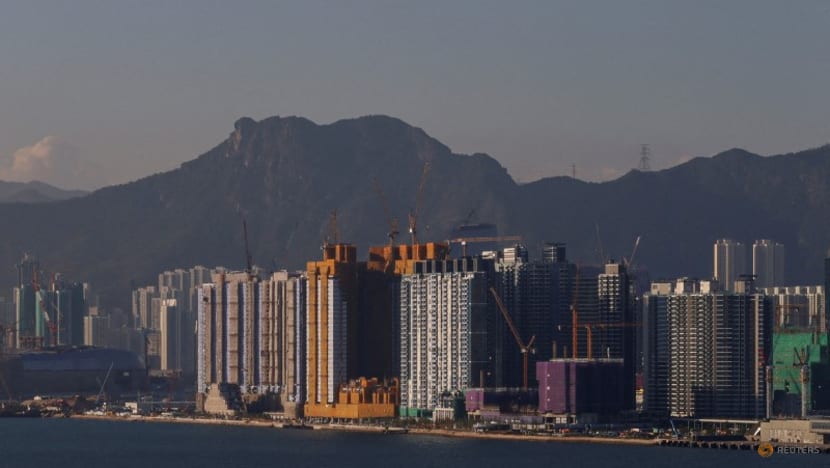Hong Kong turns to China to fill labour gaps in its construction industry
Hong Kong’s construction sector is expected to face a labour shortage of 40,000 in 2027.

FILE PHOTO: A general view of the construction site for housing buildings in Hong Kong, China October 24, 2023. REUTERS/Tyrone Siu/File Photo
HONG KONG: “Hong Kong hiring foreign labour. Monthly pay over HK$10,000 (US$1,278), includes meals and accommodation.”
“What's the process of moving to Hong Kong for work?”
“Wage hikes for 15 types of construction jobs in Hong Kong! Daily wages of up to 2,730 yuan (US$377)!”
These are just some of the advertisements online targeted at Chinese citizens to entice them to work in Hong Kong. Lately, Chinese social media platform Xiaohongshu has been abuzz with such posts on job opportunities.
Facing a worsening labour shortage, Hong Kong has turned to China to fill the gaps.
Since last July, companies in the construction and transportation industries have been able to apply to hire workers from China, marking a drastic shift in Hong Kong’s labour policy. The new policy simplifies the application procedures for these construction companies and they may also be able to get a bigger quota.
The construction sector is expected to face a labour shortage of 40,000 in 2027, four times the current 10,000. Last year, the sector employed about 400,000 workers, with nearly half of them over the age of 50.
Surveys by the Hong Kong Construction Association conducted twice a year also show that there was a more than 10 per cent shortage in manpower as of November last year, a gap its executive director Godfrey Leung called “quite significant”.
Authorities said bringing in Chinese workers is a temporary measure, but locals are worried they will be crowded out by the cheaper source of labour.
FIRMS HAVE NO CHOICE
However, some firms said they have no choice but to try and hire Chinese workers.
Chun Wo Construction, for instance, has brought in 120 Chinese workers since the relaxation of the policy.
The firm’s chairman Stephen Lee said the past few years have been particularly challenging for his industry due to the government launching several construction projects.
“Housing has been a priority in recent years, which requires a substantial workforce. Sometimes we struggle to recruit workers, making it nearly impossible to find labourers to meet the deadlines,” he said.
“The Hong Kong property market has been relatively weak in the past two years, so the demands of the private housing market remain flat. If the property market revives by 2027, the labour squeeze will become more severe.”
Hong Kong has earmarked a string of big-ticket projects in its latest infrastructure rush. These include the massive Northern Metropolis residential project and a blueprint to build more railways and tunnels across the city.
Financial chief Paul Chan said the annual public project expenditure will exceed US$12.7 billion in the next few years. Authorities in February also scrapped decade-old curbs on residential properties in a bid to bolster its flagging real estate market.
ENSURING ECONOMIC DEVELOPMENT
So far, more than 7,100 Chinese workers have been approved out of a quota of 12,000 allocated to the construction sector. Authorities said they will not be paid below the city’s prevailing median wage.
These workers are only allowed to take part in public projects worth more than US$130 million.
There are calls for the government to lower the threshold and make the labour importation scheme permanent. If the shortage continues, that could be a possibility.
“We won't allow labour shortages to hinder Hong Kong's recovery or impede economic development,” said Hong Kong Deputy Financial Secretary Michael Wong.
“Prioritising local workforce remains the foundation of our government's manpower policy. But if the worker crunch still exists after the industries have tried their best on training and providing various employment incentives, it’s inevitable for us to import labour in a moderate and regulated manner.”
It is not just workers on the construction sites that are in short supply. There is also a shortage of engineers, architects and surveyors.
The Construction Industry Council predicted a "considerable" shortage of up to 6,500 such professionals by 2027.
WAR FOR TALENT ACROSS EAST ASIA
Today, more Chinese citizens are interested in moving to Hong Kong, even if it is for a short-term project, recruitment agency Robert Walters China’s general manager Sean Li told CNA.
“The wage is far higher in Hong Kong. And to be honest, the working conditions in Hong Kong would be much better than that in China,” he said.
However, he questioned if the labour transfer is sustainable, given that the Chinese property sector, which is currently in turmoil, may need its workers back in the future.
He added that there may be a language issue, given that the Chinese do not speak Cantonese and English, the two predominant languages spoken in Hong Kong.
Even as Hong Kong courts Chinese workers, the working age population of China – the factory of the world – has been shrinking for a decade now.
The Chinese government predicted the size of this group will further shrink to 700 million by 2050 from 880 million in 2021, a drop larger than the entire population of Bangladesh.
"Digital, innovative, and complex high-skilled talents are still scarce. There is a general shortage of front-line technicians such as fitters, welders, and elderly care workers,” said Chinese Minister of Human Resources and Social Security Wang Xiaoping, during the country’s annual Two Sessions meetings last month.
Other East Asian nations are also facing labour shortage amid tumbling birth rates.
Japan, Asia's second-largest economy, may face a shortage of more than 11 million workers by 2040, according to a 2023 study. From tapping on foreign workers to mobilising robots, the country is in a desperate rush to plug the gap.
Last year, South Korea beat its own record for having the world’s lowest birth rate, reporting 0.72 births per woman for 2023, down from 0.78 in 2022. The largely homogeneous country has turned to foreign workers as a solution.
Facing a worsening labour crunch, Taiwan has also turned to India for a new supply of foreign workers.

















